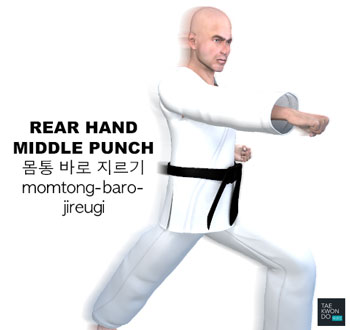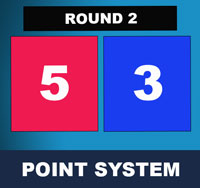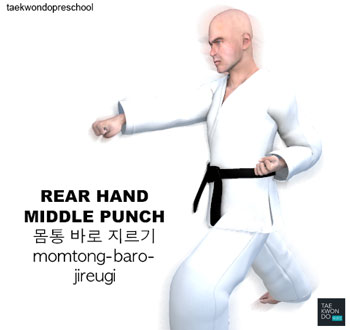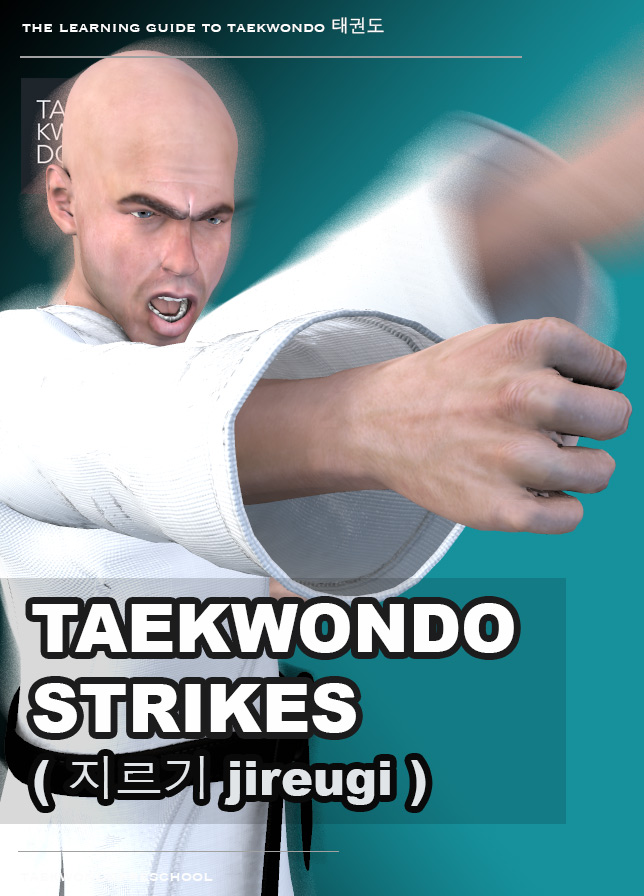Taekwondo 태권도Taekwondo Preschool
When you reach senior belt you are expected to guide the junior belts when they are beginning Taekwondo such as showing by example. To advance from one rank to the next, students typically complete promotion tests in which they demonstrate their proficiency in the various aspects of the art before a panel of judges or their teacher. View Taekwondo belt levels »

Rear Hand Middle Punch
몸통 바로 지르기 momtong-baro-jireugi
Difficulty Level: Beginner Technique: Strikes ( 지르기 jireugi )
Rear Hand Middle Punch ( 몸통 바로 지르기 momtong-baro-jireugi ) is a punch that uses the same arm as the back leg to throw a punch to the opponent. The movement carries the weight of the body and power comes from turning the body as well. The strike is most commonly performed with the Front Stance ( 앞굽이 ap-kubi ) or the Walking Stance ( 앞서기 ap-sogi ) in taekwondo patterns ( 품새 poomse ).
The wrist ( 팔목 palmok ) must also be kept in proper alignment during a fist strike. If the wrist ( 팔목 palmok ) bends on impact, it can easily be sprained, dislocated or broken.
Strikes should generally be thrown with some measure of shifting body weight supporting the blow, as opposed to just the striking with the fist. Strikes should aim for a point 4–6 inches (10–15 cm) behind the target surface, to impart the most energy into the target. The striker in combat should attempt to strike through the target area, not just contact the surface.
Use of this strike ( 지르기 jireugi ) is featured prominently in many of the World Taekwondo (WT) Poomse. Taekwondo poomse are the learning ground for real combat. As such, the muscles of the body should be lightly relaxed in order to perform the pattern with fluidity, speed and grace. Muscles should only be tensed at the moment of imaginary impact in order to commute maximum power to any individual taekwondo technique.
Variations
- Low Punch ( 아래 지르기 arae-jireugi )
- Middle Punch ( 몸통 지르기 momtong-jireugi )
- High Punch ( 올려 지르기 olgul-jireugi )
- Double Punch ( 몸통 두번 지르기 dubeon-jireugi )
- Downward Punch ( 내려지르기 naeryeo-jireugi )
- Vertical Punch ( 세워지르기 sewo-jireugi )
- Front Hand Middle Punch ( 몸통 반대 지르기 momtong-bandae-jireugi )
- Rear Hand Middle Punch ( 몸통 바로 지르기 momtong-baro-jireugi )
Training Methods
How well one improves with training depends on several factors, such as the frequency it is engaged in, and the type of feedback that is available for improvement. If a student does not train often enough, reinforcement fades, and he or she is likely to forget what was learned.
During training, taekwondo practitioners may use various equipment and gear for practicing the strike. Taekwondo extensively uses the heavy bag for developing power and endurance. Powerful strikes to the heavy bag aren't recommended for inexperienced, or younger athletes, as risk of sprain, strain, or bone plate damage may adversely affect bone structures. It is highly recommended to carefully focus strikes to reduce chance of injury.
The strike is best learned initially striking at the air as though there is an opponent but focusing on the form, speed, and technique; then moving on to soft surfaces striking punch mitts and target pads. Large heavy bags are used more for strength and endurance, while smaller targets such as punch mitts and target pads focus on faster hand speed, timing and coordination. Target pads are useful for training mobility and accuracy on a moving target.
Also a chest protector ( 호구 hogu ) worn by a partner can be used as a stationary or moving target which is useful for getting the feel of impacting the opponent. The chest protector ( 호구 hogu ) is the armor worn by practitioners of taekwondo during sparring ( 겨루기 gyeorugi ).
In preparation for full contact sparring, students may be required to wait a few months, for safety reasons, because they must first build the skills they would ideally employ in their sparring practice. Some schools restrict the amount of force that may be used to hit an opponent, by allowing 'light contact' during sparring. Light contact allows a student to hit an opponent getting the feel of impacting the opponent but with controlled force and not full power. Light contact sparring is a good method to practice the technique.
Difficulty of Technique
Taekwondo students of geup ranking learn the most basic techniques first, and then move on to more advanced and difficult techniques as they approach 1st Dan Black Belt. The more difficult the technique, the more practice may be needed for the purpose of improving or mastering it, as in the phrase 'practice makes perfect'. Every technique must display the requisite speed, balance, power and firmness to be realistically used as an attack or defense move.
* Please see a certified Master Instructor ( 사범님 sabeomnim ) for training. Proper guidance and instructions are needed to ensure safe training.
Promotion Tests
Students often undergo periodic testing and grading by their own Master Instructor ( 사범님 sabeomnim ) in order to advance to a higher level of recognized achievement such as a different belt color. They need to demonstrate their proficiency in the various aspects of the art such as the execution of patterns ( 품새 poomse ), which combine various techniques in specific sequences.
Rear Hand Middle Punch ( 몸통 바로 지르기 momtong-baro-jireugi ) is a requirement for the below belt levels (Techniques vary between schools). Promotion from one belt level to the next can proceed rapidly in some schools, since schools often allow geup promotions every two, three, or four months. Students of geup rank learn the most basic techniques first, and then move on to more advanced techniques as they approach first dan black belt. View Promotion Tests »

Highlight World Taekwondo (WT) Tournament Point System
Under World Taekwondo (WT) and Olympic rules, sparring ( 겨루기 gyeorugi ) is a full-contact event and takes place between two competitors in an area measuring 8 meters square. Points are awarded for permitted, accurate, and powerful techniques to the legal scoring areas; light contact does not score any points. The only techniques allowed are kicks ( 차기 chagi ) (delivering a strike using an area of the foot below the ankle) and punches ( 지르기 jireugi ) (delivering a strike using the closed fist). The referee can give penalties at any time for rule-breaking, such as hitting an area not recognized as a target, usually the legs or groin ( 샅 sat ). View Tournament Point System »
* Please see a certified Master Instructor ( 사범님 sabeomnim ) for training. Proper guidance and instructions are needed to ensure safe training.

Training Highlights Summary
The Strike contains many key point highlights. There are some that are simple and straightforward but then some are complex and detailed that require repeated training to learn and master.
- strike commonly originating from a chambered position aimed at the mid-section
- punch that uses the same arm as the back leg to throw a punch to the opponent
- wrist must also be kept in proper alignment during a fist strike
- strikers generally exhale as the strike nears the target
Strength Requirement of the Technique
Most strikes should generally be thrown with some measure of shifting body weight supporting the blow. The striker in combat should attempt to strike through the target area, not just contact the surface. Some strikes do not need as much strength as they target vulnerable areas such as the eyes ( 눈 nun ), neck ( 목 mok ) or sternum ( 흉골 hyung-gol ). The below is an approximate measurement of how much strength the strike requires from the practitioner to be effective.
Precision of Striking Technique
With proper execution opponents may be incapacitated with a single striking blow, which lessens the number of further strikes. Some techniques can strike with more precision which will often cripple or knockout the opponent. The below is an approximate measurement of how precise the strike requires from the practitioner to be effective.
Experienced practitioners learn through repetition and muscle memory when (not just how) to launch particular strikes, based on the circumstances they are facing.
* Please see a certified Master Instructor ( 사범님 sabeomnim ) for training. Proper guidance and instructions are needed to ensure safe training.
There are five tenets defined in the International Taekwondo Federation (ITF) and several more in World Taekwondo (WT).
Indomitable Spirit ( 백절불굴 baekjul-boolgool ): "To have indomitable spirit means to have the courage to stand up for what you believe in, no matter what odds you are up against, and to always give 100% effort in whatever you do." View Taekwondo Tenets »
RESOURCES
This article uses material from the Wikipedia articles "List of Taekwondo Techniques", "Fist (hand)" and "Strikes (attack)", which is released under the Creative Commons Attribution-Share-Alike License 3.0.






































